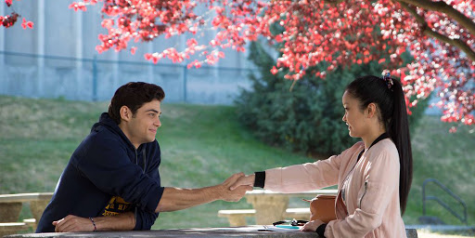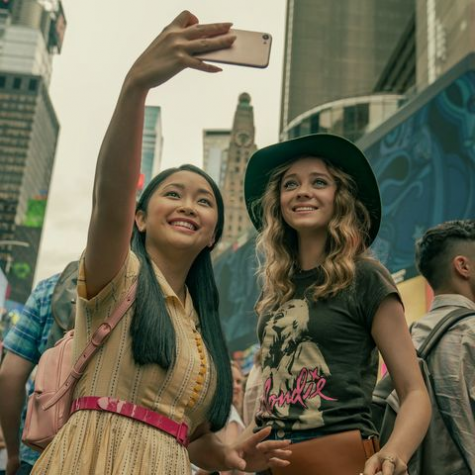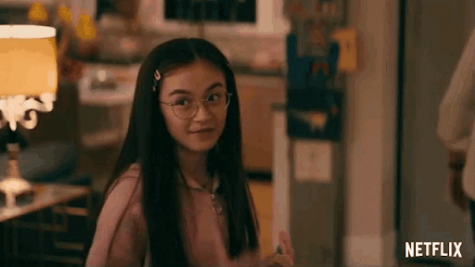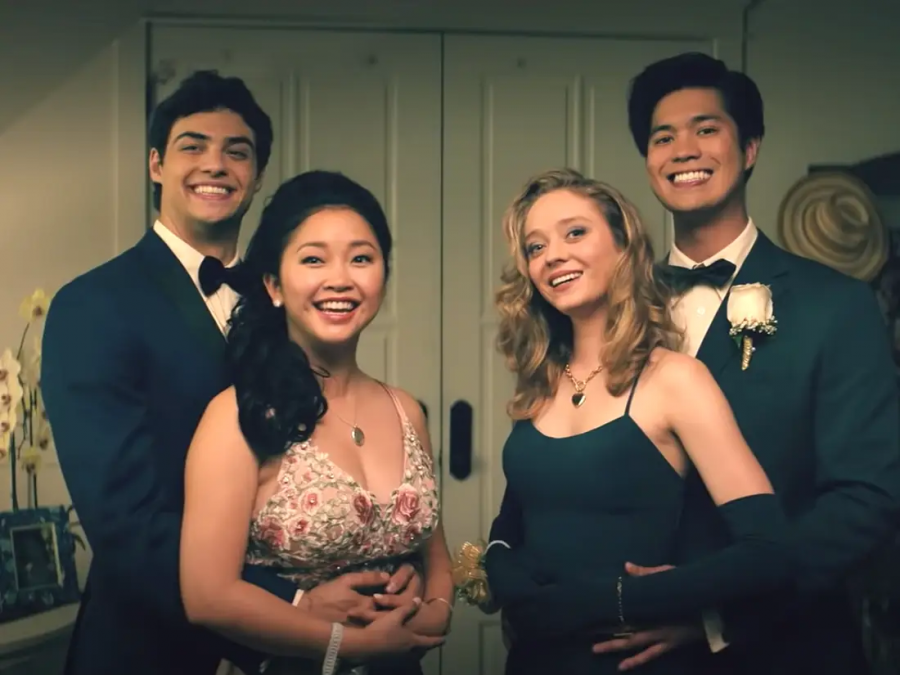To All The Boys: Always and Forever (2021): Did it live up to my nonexistent standards?
Although it didn’t aggressively slam into the mud, it wasn’t what it could’ve been
February 15, 2021
From left to right, Peter (Noah Centineo), Lara Jean (Lana Condor), Chrissy (Madeleine Arthur), and Trevor (Ross Butler) on their senior prom night.
Possible spoiler alert: read at your own risk.
Three years ago, I stumbled upon Jenny Han’s “To All The Boys I’ve Loved Before” trilogy, and I’ve had absolutely no regrets. (According to my Fairfax County Public Library history, I borrowed it digitally three times until my sister and I sucked it up and bought the books.) As an avid reader of realistic fiction throughout my childhood, I thought it would just be yet another ironically unrealistic story about a teenager’s life, but I was, for the most part, pleasantly surprised. “To All the Boys” wasn’t perfect, but at least it wasn’t entirely a made up story. It had a mostly “realistic fiction” style and somewhat relatable plot: three half-Korean sisters, Margot, Lara Jean, and Kitty, living in Charlottesville, Va. with relatively mundane lives, simping on the cute next-door neighbor who happens to be dating Margot.
Lara Jean, the protagonist, is a bit of a hopeless romantic (like me, if I may say so). She keeps the letters that she has written to boys she’s “loved” in a hatbox gifted to her by her deceased mother, intended only for her own eyes. However, her younger sister, Kitty, puts them in the mail (as one does), starting the chain of events that eventually leads to Lara Jean fake-but-not-so-fake dating Peter, the popular (and hot) lacrosse jock at her school. In the original trilogy, I appreciated the subtle references to many familiar University of Virginia (UVA) traditions and specialties — from Trick-or-Treating on the Lawn to Bodo’s Bagels — which tied the story to author Han’s Virginian roots and made it feel relatable to me, an Asian-American girl from Virginia.

When the movie adaptation of the first book, “To All the Boys I Loved Before”, came out, I wasn’t disappointed. With three talented Asian-American females in starring roles, who would be? The books were originally written in a way where the half-Korean Covey sisters could easily be swapped out with white actresses, but Hollywood stayed true to Han’s original intentions. Lana Condor, Janel Parrish, and Anna Cathcart, playing Lara Jean, Margot, and Kitty, respectively, all conveyed the struggles of high school life and sibling rivalry, with hints of their Asian heritage sprinkled throughout the dialogue (Yakult, anyone?). Although I was sad that they stripped the movie entirely of the book’s Charlottesville setting and UVA references, “To All the Boys I’ve Loved Before” was relatively true to the book while forging its own identity. However, the second movie, “To All the Boys: P.S. I Still Love You”, didn’t make the already low bar that the book set, which made me nervous for the third and final installment.
After watching the trailer of “To All the Boys: Always and Forever” in late January, I was slightly (okay, very) horrified by the changes that I could see. I had mostly gotten over the intentional setting blurring, but after Lara Jean and Peter’s dream college changed from UVA in the book to Stanford in the movie, and Lara Jean didn’t make it in, I decided that I would drop my expectations of the movie to absolutely nothing. Given that Stanford has a 4% acceptance rate, the rejection shouldn’t have come as a surprise to Lara Jean — not everyone who is qualified makes it in. In any case, in the weeks leading up to the movie’s release, I was worried that previously realistic details included in the book would be marred and scarred in the movie.
Well, most details remained realistic, although the original plot was still thoroughly tarnished nonetheless. There were a horrendous and unholy number of changes from the book in this adaptation, which would’ve been fine if they had been pulled off well, but they weren’t. From Lara Jean’s altered college list to a sudden hometown reveal to Kitty’s random Korean love interest, there were a lot of odd and poorly altered details to unpack. It would take up more words to sum up the issues I had with the adaptation than the minimum word count on the HUM essay you’ve been procrastinating on, so I’ll just hit my biggest three points below.
First, Lara Jean’s college list had only three schools. The aforementioned Stanford, the “East Coast” New York University, and the “backup” University of California, Berkeley. All three of these schools have acceptance rates under 20%. She’d have to be borderline delusional to apply exclusively to these three schools and expect to get in. Teen Vogue’s review mentioned Lara Jean’s rejection as a change from the typical model minority myth, but as the stereotype’s name suggests, it’s not the reality.
Additionally, I think if they weren’t going to set it in Charlottesville, they should’ve maintained their purposeful vagueness concerning Lara Jean’s hometown. There wasn’t a definite purpose for establishing Portland as the setting, except for the minor scene where Kitty talks about not wanting Lara Jean to go to NYU because of its distance. (New York City is a nearly six hour drive from Charlottesville!) After tainting the book’s original setting, I just don’t think it was necessary for them to suddenly bring up her hometown in the last installment for a minor line in the dialogue.

Also, much of Lara Jean’s spring break trip to Korea was what I imagined Hollywood would make it: badly stereotyped. For example, I wasn’t surprised that Lara Jean was uncomfortable with someone going up to her speaking in Korean, assuming she was one of them (although she is visibly mixed and therefore would not be considered actually Korean). However, the part about Dae, Kitty’s “boyfriend” from Korea, was totally irrelevant, weird, and mildly unexpected — they should not have added an extra character for no reason, other than, perhaps, to have a “diverse cast”. Kitty’s still young — is she even in high school? There’s no need to pair her with someone, let alone a random boy she met at a tourist destination! It seemed insensitive to throw together a meet-cute with a Korean boy and a mixed Korean-American girl without an explicit purpose. Kitty and Dae’s relationship was mentioned a maximum of three times throughout the entire movie, and Dae was portrayed in a typical “strangely un-American” manner, which definitely rubbed me the wrong way. Asians are already portrayed unrealistically in Hollywood and elsewhere; there’s no need to worsen it here.
All that was not to say that “Always and Forever” was a bad movie — it was a more than adequate standalone and far better than “P.S. I Still Love You”. It gave off a bit of a different vibe, which was particularly noticeable in the NYC scenes and the animated transitions between drastically different environments. I liked how they incorporated k-pop into the movie, although it certainly wasn’t necessary to load the entire movie with an overwhelming number of songs as background music. However, the best part of the movie was the subtle but wholesome character development.
Peter, in particular, saw a lot of character development throughout the trilogy. He started off as a stereotypical a-hole jock, but he really showed emotional maturity in many scenes in “Always and Forever”. A scene that stuck out to me was when Lara Jean broke the news to him that she had been rejected by Stanford, and the first thing Peter asked was, “Are you okay?” with exactly the amount of support and sensitivity that she needed. He also showed a lot of vulnerability in his interactions with his estranged father, and I was impressed by Peter’s patience and willingness to reconnect with him. Although he returned briefly to his previous self-centered self towards the end during the short breakup, his growth was quite satisfying; I am definitely on Team Peter.

“Always and Forever” also definitely lived up to its rom-com name. Kitty was absolutely adorable yet sarcastically sassy — nothing short of what Anna Cathcart can deliver. Chrissy (who was named exclusively Chris in the books, by the way) was an iconic comedic character, much like in the previous two movies. Combined with Dr. Covey’s humorous inserts and Chris’s cousin Gen’s chaotic popular girl vibe, there were plenty of hilarious moments throughout the movie, which made up for the train wreck of plot changes.
Key takeaways? Never do anything exclusively for a boy. Jokes aside, overall, they got the gist of the movie right. I’ll give them that. It was also sweet of them to finish the trilogy by featuring Jenny Han in a cameo at the end. Was it worth two hours of my life? I had a good time watching (or rather, shrieking and criticizing) it with my sister and two friends. If you have Netflix, haven’t read the books before, and have someone to laugh at it with, go ahead and watch it! There’s not a whole lot of harm you can do to yourself with that setup. If you have read the books already, though, either go in with incredibly low expectations or just pass on this one.
